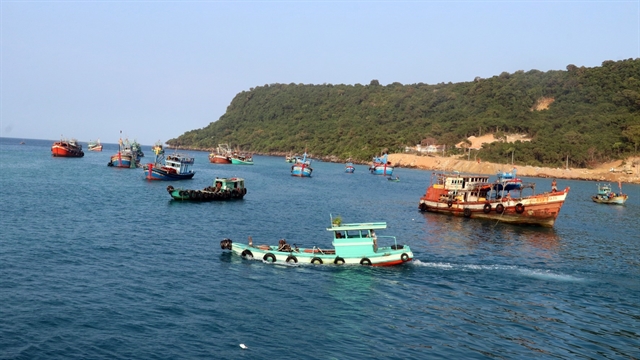 Society
Society

The fishing and aquaculture output of the Cửu Long (Mekong) Delta province of Kiên Giang has topped 836,200 tonnes this year, 10.8 per cent higher than the target, according to its Department of Agriculture and Rural Development.

|
| Fishing boats dock at Thổ Chu Island in Kiên Giang Province’s Phú Quốc District. — VNA/VNS Photo Lê Huy Hải |
KIÊN GIANG — The fishing and aquaculture output of the Cửu Long (Mekong) Delta province of Kiên Giang has topped 836,200 tonnes this year, 10.8 per cent higher than the target, according to its Department of Agriculture and Rural Development.
Fishing accounted for more than 572,000 tonnes.
Quảng Trọng Thao, deputy director of the department, said the province has restructured the sector to reduce near-shore fishing and expand off-shore fishing.
The province has strengthened advocacy to enhance fishermen’s awareness of protecting fishery resources and penalises people who violate fishery exploiting and protecting regulations, he said.
The province is entering the natural ark clam and yellow clam harvest season and is stepping up measures to protect the species from overexploitation.
The harvest will be done from now until May next year.
Only fishing boats of less than 12 metres in length have been granted licences to catch the clams, and they have to be equipped with sufficient tools to comply with catching regulations. The department has instructed relevant agencies and localities to tighten inspection over the activity and penalise violators.
In Kiên Giang, ark clams and yellow clams are found mostly off the coasts of Kiên Lương District and Hà Tiên City.
Thao said the province catches hundreds of tonnes a year for both domestic consumption and export.
Aquaculture
The province has zoned areas for farming aquatic species, especially shrimp and other high-value ones, Thao said.
It has strengthened fishery extension activities and taught farmers advanced farming techniques, especially for shrimp.
The shrimp yield with advanced methods is 30 - 50 tonnes per hectare per crop compared to 10 -12 tonnes under traditional farming methods, according to the department.
The province has developed industrial shrimp breeding models using semi-biofloc and biofloc technology, and a model of breeding in two stages to increase yield.
Under the latter, juvenile shrimp are first bred in a small pond for a few weeks before being transferred to the main pond for intensive breeding in the second stage.
In 2016-19 the department set up 44 sites for farmers to visit and learn.
The model offers an average income of VNĐ280 million ($12,000) per hectare per year.
The province has developed industrial shrimp breeding in the Long Xuyên Quadrangle and turned low-yield rice fields into rice-shrimp farming fields in which farmers cultivate the grain during the rainy season and breed shrimp the rest of the time.
The province, the delta’s largest rice producer and one of the largest shrimp producers, has 100,000ha under rice-shrimp fields this year, 28 per cent higher than in 2015.
Danh Mẫn, who has a 3ha field in An Biên District’s Đông Yên Commune, said he earned VNĐ180 million ($7,700) this year from it.
“After switching to rice-shrimp farming, my family’s income has been steady,” he said.
Nguyễn Văn Hồng of Gò Quao District’s Vĩnh Thắng Commune said when he grew only rice on his 1ha field, his income could not cover his family’s living costs but now, after switching to rice-shrimp, he earns VNĐ70 – 80 million ($3,000 – 3,400) a year and has escaped poverty.
The model is adapted to climate change and sustainable since farmers use few chemicals.
The rice and shrimp produced are clean and preferred by consumers.
Gò Quao District has turned more than 2,700ha of rice fields into rice-shrimp fields, pineapple farms, pepper fields, and fruit orchards in the last five years.
Lê Hữu Toàn, its People’s Committee deputy chairman, said the district has created concentrated aquaculture areas with the application of advanced farming techniques and diverse models for breeding various species such as black tiger shrimp, white-legged shrimp and giant river shrimp together in a single pond.
The value of the district’s aquaculture production has increased from VNĐ418 billion ($18 million) in 2015 to VNĐ636 billion ($27.4 million) this year. — VNS




